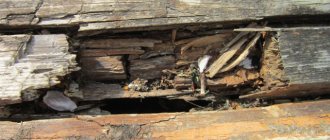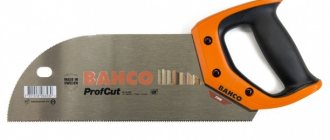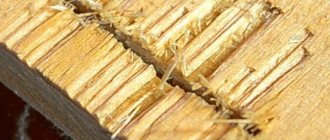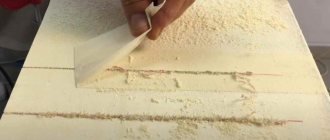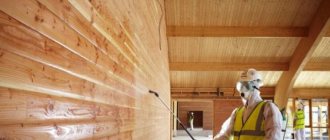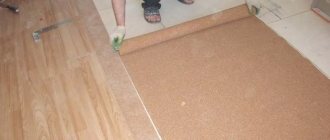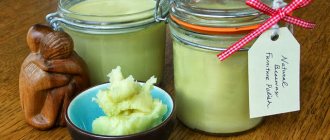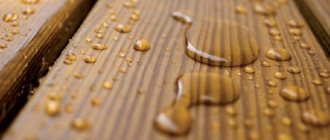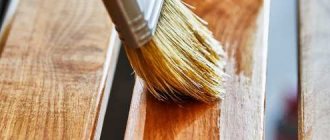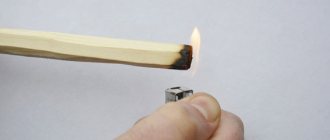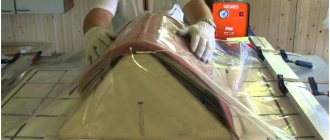Plywood occupies one of the main places on the construction goods market. This material is made by gluing and then pressing several pieces of wood veneer. The product is valued for its versatility in use and affordability.
However, despite its advantages, the product has one weak point: low moisture resistance. To eliminate this drawback and protect the material from moisture, a manipulation such as waterproofing plywood is performed. Therefore, everyone who is busy building or renovating a house will sooner or later have to solve the problem: what can be used to impregnate plywood to make it moisture-resistant.
The need for waterproofing plywood
The surface of plywood is very sensitive to external influences, subject to rapid wear without proper impregnation and penetration of water or other liquid substances, therefore it requires special treatment, which allows waterproofing the wood.
In particular, this treatment is required for plywood, which is often used at home to make DIY bookcases or small pieces of furniture, children's crafts, because it is cheap and easily available, in most cases it does not require expensive ones.
General information
As you know, plywood is a multilayer material consisting of veneer sheets glued together. As a result, the degree of moisture resistance determines the type of binder component. The most moisture-resistant are bakelized plywood brands, the veneer sheets of which are impregnated with bakelite varnish or glue.
They tolerate even direct exposure to water, so they can even be used for the manufacture of swimming equipment without any additional impregnation. The only serious drawback of this material is the very high price.
An example of slab delamination as a result of exposure to moisture
Regular FK plywood, which is most often used in construction and the furniture industry, begins to delaminate and rot over time due to exposure to moisture. However, its moisture resistance can be increased by using impregnations and other types of processing. Moreover, some processing methods allow the material to tolerate even direct contact with water.
Types of waterproofing impregnations
The following waterproofing options are available on the market for household needs:
- Oil-based varnishes and paints;
- Water soluble;
- Solvent based.
Modern waterproofing impregnations usually combine synthetic and natural oils, as well as organic solvents. They can be colored or colorless, in the form of varnish or paint, it all depends on the composition.
In addition to the function of insulation from water, modern protective products are also produced to protect against the biological effects of rodents, insects and fire. Water-repellent impregnations for plywood are available in liquid and gel forms.
Features of the structure
The basis of the plywood production process is gluing thin sheets of wood together so that the natural fibers are directed strictly along or across the long side. The number of layers is most often odd, the minimum is 3 sheets.
Bonding is carried out by various means, of which effective water resistance is provided by certain bakelite compositions: varnishes and alcohol-soluble adhesives. The use of water-soluble modifications of Bakelite and all other types of adhesives leads to the fact that the products cannot withstand the action of water vapor. Low water resistance is especially noticeable when using plywood outdoors. In this regard, it is necessary to treat the material with protective compounds.
Preparatory work
Preparing the plywood before applying the first base coat is very important. Wood, and especially laminated wood products, is a material that expands and contracts, and waterproofing must take these movements into account.
Sun and winter cold, especially outdoors, greatly contribute to drying and shrinkage.
First of all, you should always keep in mind that water-repellent impregnation, varnish or paint adheres more firmly to a porous surface than to a smooth one, so if necessary, a thorough rubbing with 100-grit sandpaper will help prepare the plywood for good adhesion.
How to waterproof plywood
First of all, we purchase everything you need:
- Impregnating agent;
- Brush;
- Sandpaper;
- Wood puller;
- Gloves, paper towels;
- Solvent.
Next, we carefully wipe the surface of interest with a damp cloth. The first step after thoroughly cleaning the wood is to use sandpaper along with a stripper: this will help us remove all traces of paint from the wood. If the wood seems to us to be in excellent condition, we can begin applying varnish.
To apply the primer, you can use a brush: at this stage, when forming the first layer, we pay close attention to the direction of application. In fact, it is important that the wood texture is respected.
After 24 hours, a second coat of impregnating agent can be applied, taking care to leave no defects as far as possible and making the surface as uniform as possible. To suit your taste, if desired, we can transfer the paint by color or choose a colored impregnating agent right away.
Pasting with fiberglass
This waterproofing of plywood significantly increases the service life of the material. It is produced by applying a special glass fabric to the surface. If such material is not available to you, you can use ordinary gauze. Any of these materials is glued using varnish. The main condition when choosing such a solution is that it should not contain polyester and epoxy components.
Carry out work with fiberglass or gauze in the following sequence:
- Coat the plywood sheet with varnish.
- Let the varnish soak in for 3 hours.
- Apply gauze or fiberglass to the surface.
- Apply varnish to the ends of the sheet.
- Leave to dry for several days.
- When you are sure that the varnish has dried, reapply the varnish to the entire surface of the plywood.
- Dry for a few more days.
Choosing a waterproofing product
If you want a truly protective coating, purchase a product from the hardware store that is both preservative and waterproof and use it as a protective coating.
- However, whether you have applied a topcoat or not, the next step is to apply the basecoat.
- For plywood, especially if it is to be placed outdoors, it should be of the alkyd type, that is, oil-based.
- It must be distributed as evenly as possible over the dry sheet or parts. Pay special attention to ensure that the parts that will come into contact with the ground are well covered.
Now we come to the decorative layers, of which there should be two, in addition to the base layer. Don't think that adding more coats of paint will give you better protection, you're wrong.
Anyone who thinks about completely waterproofing plywood so that winter moisture does not penetrate into it is very mistaken: it will penetrate the same way, even if you put in more effort, but in the summer it will still come out, passing through a thick layer of paint, which will probably swell or crack.
Application of additional materials
Auxiliary materials used:
- Putty designed specifically for wood. This will allow you to create a smooth surface for paint.
- Using a primer. The primer is based on polymers. It penetrates deep into the surface, giving it excellent grip (adhesion).
- Application of varnish. It is applied on top of the paint. The varnish is used for two types of coating: wall and floor. You can create hydrophobic coatings.
- The surface is treated using adhesive sandpaper.
- The putty is applied and dried.
- The plywood is sanded using a thin ambrasive.
These were additional tips when working with plywood.
Waterproofing Tools
Manual brush strokes provide better protection than using a roller or spray. Take care to choose the right and, above all, high-quality brush.
- Be careful not to move the brush in all directions, but only in one direction, in long, regular strokes.
- If you apply too much paint at once, it will almost certainly crack within a short time.
- After applying the first coat of paint, you need to wait for it to dry completely before moving on to the second.
Also, between one coat and the next, it is good to remove any impurities using very fine sandpaper, from 220 to 320 depending on the impurities present.
Once this is done, use a damp sponge to remove any remaining dust that could cause granules or other unsightly effects.
Lamination
Laminated plywood is a material covered with film, plastic or metal plates. Bonding of plastic and film to the surface is carried out using phenol-formaldehyde resins, which are applied to the surface in a heated state. The film or sheet of plastic is then pressed onto the sheet and placed under a press, where high pressure causes it to be securely attached to the sheet. The finished sheet is removed from the press, cooled and the ends are coated with a moisture-resistant compound.
However, it is always worth remembering that various methods of impregnation or processing can only increase resistance capabilities, but it is best to place such structures under structures of another type that will protect it from moisture. If the external walls of a building are covered with laminated veneer slabs, then the best protection for them can be the roof overhangs. In addition, when installing on vertical surfaces, the fibers of the outer layer must be positioned vertically.
Impregnation with drying oil as an alternative method
As an alternative to impregnating paints for waterproofing wood, you can use drying oil and products based on it. This method is more expensive, but guarantees greater sophistication, and in versions containing a base of sealants, it guarantees a designer highlight of the uniform color of the plywood.
- This procedure is usually used on small pieces of wood because it is a messier method and requires better protection for the worker.
- As with varnish and paint, the plywood surface must be properly prepared by removing initial dirt and excess paint, as well as marks and chips.
- After application, drying oil will make the wood shiny and, as a result, highlight stains and defects, if any.
Drying oil should not be applied directly to the wooden surface, but to a rag, which can then be used to rub the affected part of the wood. After 30-45 minutes, you can remove the excess with a clean cloth and then let it dry completely for 24 hours.
Processing methods
Processing plywood and protecting it from moisture can be done in several ways. Here are some of them (the most common in everyday life):
- puttying with PVA glue;
- coating with drying oil;
- treatment with nitro paints;
- gluing fiberglass.
Next, we’ll take a closer look at the best way to process plywood and how to do it correctly.
PVA
Protecting plywood from moisture and rot with PVA putty has many advantages. It reliably protects the material from many negative factors. Here are step-by-step instructions on how to complete the protection process:
- Before treating the material to increase moisture resistance, it is placed parallel to the floor and a layer of PVA glue is applied.
- Allow time for the initial layer to be well absorbed, after which it is covered with another layer of PVA.
- Continue the process until glue stains begin to appear on the underside of the sheet.
- The plate is turned over and the impregnation process is repeated.
After the work is completed, the slab is laid on a flat surface and allowed to dry under natural conditions. The disadvantages of this process include rather long processing times. Plywood will have to be protected from moisture for 3-4 days.
A similar impregnation can be done using epoxy resin. But this is quite an expensive pleasure and at the same time not harmless to human health. Sheets treated with epoxy resin are used for exterior use only.
Drying oil
Drying oil is the simplest way to impregnate a plywood board from water. Processing is carried out in the following way:
- The solution (oil for plywood) should first be heated to a temperature level of 600C, due to this its penetrating ability increases.
- Then we impregnate the horizontally located sheet with drying oil using a brush.
- After completing the impregnation process on one side, we proceed to the other.
- Be sure to thoroughly coat the ends of the plywood.
- When the first layer is applied, we begin to force-dry it using an iron or hair dryer.
- After drying is completed, we begin the repeated process of applying drying oil and forced drying.
The number of layers may vary. Stop treating with drying oil only when the solution stops being absorbed by the material (the water-repellent effect is fully achieved).
After this treatment, paint or varnish can be applied to the plywood. The question often arises about how to cover plywood on the floor. This method is ideal for this purpose.
Fiberglass
You can also protect plywood with fiberglass, but to do this you need to use waterproof varnishes that do not contain epoxy or polyester resins. The protection technology consists of the following steps:
- The sanded plate is painted with varnish.
- After allowing the applied layer of varnish to dry for about two hours, fiberglass is glued onto the surface of the plywood.
- Re-apply a layer of varnish to the ends of the slab and leave until completely dry.
- The treatment is completed by applying another layer of varnish and drying the impregnated plywood under natural conditions.
Advice! If fiberglass is not available, you can use regular gauze. After it has been painted with varnish, it will reliably protect the material.
Nitropaint
Another way to treat plywood from moisture is with nitro paints. This is especially true when the material will be in direct contact with water, for example, when repairing a boat or arranging a damp room.
Here are instructions for doing the work yourself:
- Initially, it is necessary to sand the surface and cover it with drying oil.
- Allow the drying oil layer to dry completely and apply liquid paint as a primer.
- Apply a layer of nitro paint to the sheets protected with primer.
- We cover the surface of the plywood with a cloth, which at the same time must be impregnated with nitro solvents.
- After drying is completed, it is treated a second time with diluted nitro paint. The resulting moisture-resistant material is even suitable for making a boat.
Important! The last layer of nitro paint is made quite thin. Otherwise, the degree of strength decreases.
Cost of work
Surely, as you already guessed, the cheapest method is to use drying oil. The cost of waterproofing depends on the surface being treated and the conditions in which it is located.
For those who do not have experience and are not familiar with homemade products, it is recommended to carry out operations with specially developed compounds, although this is more expensive.
